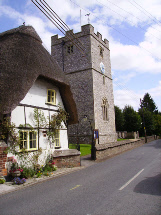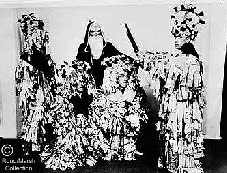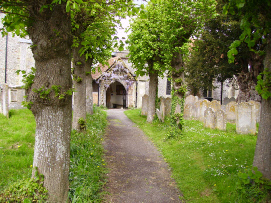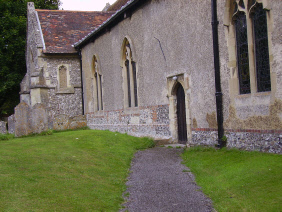Old Village Customs
Christmas customs in ancient times at St. Peter’s church St. Mary Bourne
( Old Christmas was celebrated on January the. 6th)
Old Christmas was celebrated on January the. 6th)
As worthy of revel days of Bourne, it was the custom forty years ago to carry on
sad doings in the church on old Christmas Eve. A huge fire was set blazing in the
belfry, the smoke getting out through the tower as best it could. During this sooty
usage the old bells pealed out one-
The oak to repair the timbers was brought from Tadley at a cost of 7s.6d.per load. (Dr. Joseph Stevens)
The Salisbury and Winchester Journal Monday December 31st. 1827.
On Christmas day the children belonging to the Kingsomborne Sunday school, consisting of 98 girls and 75 boys, were liberally entertained by the Rev. Mr. Taylor, and the ladies and gentlemen of that place, with Beef and Plum pudding after which the teachers sat down to an excellent dinner, consisting of the same old English fare.
 The Mummers or Christmas Boys
The Mummers or Christmas Boys
When Christmas came around, its festivities were heightened by the appearance of
a small band of youths, who went through a popular pantomime at most of the houses
in the parish where residents were likely to furnish some entertainment on the spot,
or contribute a small sum towards the providing a supper and ale elsewhere. Mummer
means masker. The play was conducted by half-
About Mummers Plays
Mummers Plays have been performed in England, Scotland, Wales and Ireland for hundreds of years. They are folk dramas based on the legend of St. George and the seven champions of Christendom. They were originally mime or dumb shows (Thus mummers from the middle English word mum, meaning silent.) where all the performers were disguised and known as “Guisers”. All the characters were played by men who kept the same part for many years. Eventually, dialogue was added, but was passed on by word of mouth. Consequently, the “Chinese Whispers” effect over the centuries and the loss of the real significance of the original story, makes present day performances very entertaining but virtually meaningless to most audiences.
The principal characters are St.George (Of dragon fame). Captain Slasher. The Turkish Knight. The King of Egypt. Doctor and several men-at-arms who challenge St. George to a duel and are subsequently slain. The Doctor enters and demonstrates his skill by resuscitating the dead knights.
Many historians believe that this drama is a celebration of the death of the year and its resurrection in the spring. They were sometimes performed in the street but more usually as house to house visits and in pubs.
Although the term “Mummers” has been used since medieval times, no play scripts or performance details survive from that era, and the term may have been used loosely to describe performers of several different kinds.
The earliest evidence of mummers plays as they are known today (usually involving a magical cure by a doctor) is from the mid to late 18th. century. Kevin Holdway
The plot was evidently Eastern, and founded probably on the Legend of St. George.
And there can be no doubt that the usage, continued onwards from sire to son, is
as old as the myth itself. There were various versions of the play, all of which
were alike in the principal characters. The following is as complete an adherence
to the text as I could obtain, at which I was present at the performance of, at Dipland
House, in St. Mary Bourne in 1874.The characters were the following:- Old Father Christmas. Mince Pie. A Turkish Knight. St. George. An Italian Doctor. Little John. Divested of matter that had no relation to the play, the dialogue ran as follows: Enter OLD FATHER CHRISTMAS Oh! Here come I, Old Father Christmas, welcome, or welcome not, I hope Old Father Christmas will never be forgot. Make room! room! I say! That I may lead Mince Pie this way. Walk in, Mince Pie, and act thy part. And show the gentles thy valiant heart . Enter MINCE PIE. Room! room! Good gentles all give me room to rhyme, I'll show you some festivity this Christmas time. Enter a TURKISH KNIGHT with a wooden sword. I am a valiant Turkish Knight, And dare with any man to fight; Bring me the man that bids me stand, Who says he'll cut me down with his audacious hand. I'll cut him and hack him as small as a fly, And send him to Satan to make mince pie. Enter St. GEORGE with a wooden sword. Oh! In come I, St. George, the man of courage bold, With my sword and buckler I've won three crowns of gold; I fought the fiery Dragon and brought him to the slaughter; I won a beauteous Queen of Egypt's daughter. If thy mind is high, my mind is bold, If thy blood is hot, I will make it cold. (They fight, and the TURKISH KNIGHT falls.) Turkish Knight. Oh! St. George, spare my life! Father Christmas. Is there no doctor to be found? To cure this man who's bleeding on the ground? Enter the DOCTOR. Yes! An Italian doctor's to be found To cure the Knight who's bleeding on the ground. I cure the sick of every pain, And bring the dead to life again. Father Christmas. “Doctor, what is thy fee?” The Doctor. “I'll take ten pounds of thee, But fifteen is my fee, Before I set this gallant free.” Father Christmas. “Doctor! Work thy will.” The Doctor. “I have a little bottle by my side, The fame of which spreads far and wide, I drop a drop on this poor man's nose.” (The DOCTOR Touches the TURKISH KNIGHT'S nose and the KNIGHT rises on his feet).
Enter LITTLE JACK, with sundry dolls attached to his back. Oh! In come I, little saucy Jack, With all my children on my back. Christmas comes but once a year, And when it comes it brings good cheer: Roast beef, plum pudding, and mince pie, Who likes that any better than I? Christmas ale makes us dance and sing; Money in the purse is a fine thing. “Ladies and Gentlemen, give us what you please”. The performance being over, a Christmas Carol is sung, and the Mummers depart. (Dr. Joseph Stevens) The Salisbury and Winchester Journal Sat. January 5th.1835 Christmas Customs Christmas day, in the Primitive church, was always observed as the Sabbath-day, and was, like that preceded by an eve, or vigil. Hence our present custom of keeping Christmas Eve.
On the night of this eve, our ancestors were won’t to light up candles of an uncommon size called Christmas candles, and lay a large log of wood upon the fire, called a Yule log, or Christmas block,
to illuminate the house, and, as it were, turn the night into day. The ancient method of spending the Christmas day is thus curiously described in the scarce tract, entitled, “Round about our coal fire at Christmas”:
An English gentleman, at the opening of Christmas day, on the morning had all his tenants and neighbours enter his hall by day-break. The strong beer was broached,
and the black jacks went plentifully about; with toast, sugar, nutmeg, and good Cheshire cheese. The hackin (a great sausage) must be boiled by day break,
or else two young men must take the maiden (i.e. the cook) by the arms, and run her round the market place, till she is ashamed of her laziness. At dinner, and during the holidays,
the tables were all spread from the first to the last; the sirloin of beef, the minced pies, the plum-porridge, were severally brought upon the board; every one ate heartily and was welcome,
which gave rise to the proverb, “Tis merry in the hall when beards wag all.” Evergreens- The decking of houses, churches, etc. With evergreens at Christmas was a very ancient custom, and, to the delight of those who do not like entirely to forget old times,
is still in a great measure retained. This appears, like several other Christmas observances, to have been copied by the Christians from their Pagan ancestors. Formerly this practice,
at this time, was universal. Stowe; in his survey, tells us, ”that against the feast of Christmas, every man’s house, as also their parish churches; were decked with holley , Ivy, bays,
and whatsoever the season of the year afforded green.” And the conduits and standards in the streets were likewise garnished. The laurel, a conspicuous object in modern collections of these plants,
was used by the Romans, as the emblem of peace and joy, and victory. In the Christian sense, it may be applied to the victory gained over the powers of darkness by the coming of Christ.
The mistletoe was a plant held sacred by the Druids, and suspended from the ceiling of the apartment where the pleasures of the evening are to take place,
still gives rise to a number of frolicsome gambols in the country. Christmas- Boxes, which were formally a matter of bounty, have in late times been almost demanded as a matter of right.
This tax on tradesmen, in particular says the connoisseur, gave him a pretence to lengthen out his bill, and the master and mistress to lower their wages
on account of the vails. Parliament, in 1652, by order, enjoined, “That no observation shall be had of the five and twentieth day of December,
commonly called Christmas day, nor any sole unity used or exercised in churches in respect thereof.” We live now in more liberal times. Christmas in the last Century- The country Squire of £300 a year (an independent gentleman in the reign of Queen Anne) is described as having “never played at cards but at Christmas, when the family pack was produced from the mantle-piece.” His chief-drink the year round was generally ale, except at Christmas time, when he would make a bowl of strong brandy punch, garnished with toast and nutmeg. In the corner of his hall, by the fireside, stood a large wooden two armed chair, with a cushion;
And within the chimney-corner were a couple of seats. Here at Christmas he entertained his tenants. Assembled round a glowing fire, made o
f the roots of trees, and other great logs, and told and heard the traditionary tales of the village, respecting ghosts and witches,
till fear made them afraid to move. In the mean time the jorum of ale was in continual circulation. New Years Eve- To end the old year merrily, and begin the new one well, and in friendship, were popular objects
in the celebration of this festival. It was spent among the labouring portion of our ancestors in festivity and frolic by the men, and the young women of the village
carried from door to door a bowl, which they offered to the inhabitants of every house they stopped at, singing rude congratulatory verses; and soliciting small presents.
Young men and women also exchanged clothes, which was termed mumming, or disguising; and when thus dressed in each other’s garments, they went from one
neighbour’s cottage to another singing, dancing and partaking of good cheer. Bonfire night On the 5th.of November, in order to obtain a few pence to help in celebrating what
was called " Bonfire Day," the lads of the village went from house to house in the
evening shouting the following lines...... "Remember, remember, the fifth of November, Gunpowder, treason, and plot. A stick or a stake for King George's sake. We hope he will never be forgot. If you don't give us one We'll take two, If you don't give us two, We'll take "dree". Hip, Hip, hurrah. !." (Dr. Joseph Stevens) The Salisbury and Winchester Journal Mon. June 15th. 1835 Andover- The inhabitants of this town were much enlivened on Wednesday evening last, by Mr. G. Gyngell,
the Western pyrotechnist, of Exeter, who gave a most beautiful exhibition of fire works, in the High Street, in front of the New Town Hall,
which had a remarkably fine appearance, owing to the reflection of the variegated colours. The display was witnessed by upwards of Two Thousand spectators,
the exhibition being open to all persons-rich and poor. Everyone expressed astonishment at the great precision of the various beautiful pieces; in fact,
the whole was conducted in a very scientific manner, and did very great credit to the ingenious artiste. We hear that Mr.G. intends to repeat the exhibition in the course of next week,
when we sincerely hope he will meet with that success to which his merits so richly entitle him. Shrovetide Another parochial custom was the celebration of Shrovetide (Shrove Tuesday) children
visited farmhouses, sometimes carrying an old platter or frying pan, begging, trifles
of food, and using the accompanying lines......... "Knick knock the pans hot. We be come a shroving, For a piece of pancake, For a piece of bacon, Or a piece of truckle cheese, Of Dame's own making." Perhaps the dying out for the most part of bacon curing, and of farmhouse cheese
making, led to the passing of this custom. (Kathleen Innes) May Day May Day the Rev. W. E. Easton had seven daughters, (Six of whom are buried in the
churchyard); they led the procession through the village on May days. Aged people
remembered when the place was decorated with green boughs, and a maypole was erected
at Whitsuntide, the blowing of horns, an old custom on May day, had its survival
at St. Mary Bourne, fifty years ago, in boys making "May horns" of willow bark twisted
in a spiral manner. But the May day rejoicings at that time had dwindled down to
a band of half washed chimney sweeps decorated with coloured papers and ribbons,
who danced round a walking bower, which enclosed a female of their order, the representative
probably of Maid Marian of the olden times. They extracted what music could be elicited
from the contact of shovels and brushes Later, the village festival survived as "Garland
day”, when all that remained to tell of the rejoicing of the past were little children
bearing miniature bowers from house to house, chanting "Please to see my garland".
(Dr. Joseph Stevens) Supplementary to what Dr. Stevens records of the May day customs, the custom survives
of children going around on May day with garlands of their own making, and singing
the following rhyme:- "First of May is garland day, Second of May is step- Knock at the knocker, Ring at the bell, Please for a penny for singing so well," No child has been able to explain what “Step toe day” signifies. One little boy recently
explained it as “the day when you trod on peoples toes” which the children try to
do, but could attach no meaning. It seems more likely to have some connection with
a dance, or to be a corruption. (Kathleen Innes) The Salisbury and Winchester Journal Sat. May 27th. 1820 The annual custom of Maying has been kept with the usual spirit in our neighbouring villages. Numerous Maypoles and Bowers adorned with flowers have been erected,
and all classes, the old and young, rich and poor, without exception, have joined in the sprightly dance upon the verdant green. The Salisbury and Winchester Journal Saturday September 9th. 1826 A match of cricket was played on Friday last between 11 gentlemen of St. Mary Bourne
and 11 of Hurstbourne Tarrant, which was decided in favour by the former. The Salisbury and Winchester Journal Monday April 30 1827. On Monday last a game of cricket was played on Weyhill down between 11 juvenile players
of Appleshaw and Amport, and eleven gentlemen of Hurstbourne Tarrant. Which was won
easily by the former in one innings, as will appear by the following statement. Appleshaw 1st. Innings runs 130 Byes 11 Total 141 Hurstbourne 1st. Innings runs 20 “ 2nd.Innings 74 Byes, each Innings 2 4 Total 98 It should in justice be stated, that the above match terminated to the loss of the
Hurstbourne gentlemen, yet there conduct throughout the whole game was manly and
becoming. Wedding Tradition The superstition is curious, because in many places it is the north door which is
suspect, The South Door the old belief being that the Devil escapes by the north
door which was then always kept open for this purpose, though locked at other times,
evil spirits, too are supposed to dwell in the north, and in some churchyards there
are no graves on the north side. (Dr. Joseph Stevens) The churchyard wall at the west end of the tower runs along the village street. On
the side next to the road it is some three feet high. On the churchyard side the
earth is within a few inches of its old stone coping; for the earth has crept up
the wall inch by inch through the centuries as one generation after another has been
laid there to rest. Its raised level is the only monument remaining to the un- Tell the Bees The village cobbler died in middle age and his widow ran up the garden to tell the
Bees, or more I'll luck than his death, would follow it was firmly believed. "Wake brownie wake and a new master (or mistress) take. For your master is dead". Ran the local rhyme, and if uninformed, the Bees would have taken offence and have
disappeared. (Kathleen Innes)  The south door (pictured left) being the main entrance to the church, has always
been the one used for funerals, this has been the reason given for the superstition
forbidding its use for a bride who always enters by the small north door (pictured
below). Within living memory a bride, scorning superstition announced her intention
of coming into the church by the more impressive south door. At that time there was
a sexton in whose family the office had been for generations (George Gibbons parish
clerk and sexton for forty years ) and to whom the tradition had been handed down
the brides determination was met by a resistance so strong that, convinced if she
persisted her procession would find a locked door with no key forthcoming. She gave
in and used the north door.
The south door (pictured left) being the main entrance to the church, has always
been the one used for funerals, this has been the reason given for the superstition
forbidding its use for a bride who always enters by the small north door (pictured
below). Within living memory a bride, scorning superstition announced her intention
of coming into the church by the more impressive south door. At that time there was
a sexton in whose family the office had been for generations (George Gibbons parish
clerk and sexton for forty years ) and to whom the tradition had been handed down
the brides determination was met by a resistance so strong that, convinced if she
persisted her procession would find a locked door with no key forthcoming. She gave
in and used the north door.